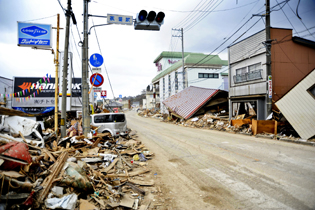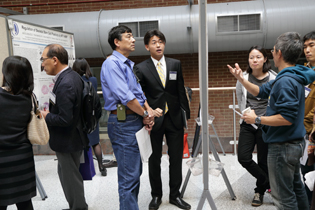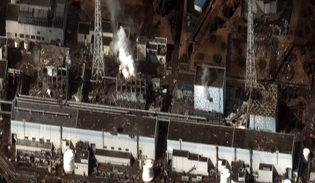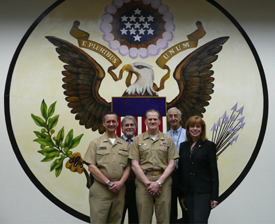Scientific Ties Across the Pacific
NIH-Japan Collaboration in Biomedical Research

U.S. NAVY
Debris, rubble and damaged vehicles line the streets for several blocks in the fishing town of Ofunato, Japan, following the March 11, 2011, 9.0-magnitude earthquake and tsunami. Research facilities in Japan were damaged, too, and NIH, which has had a decades-long collaborative relationship with Japanese scientists, played a role in helping the displaced researchers get back to work. That collaboration continues with regularly scheduled symposia and other activities.
The earthquake was punishing enough, damaging more than a half-million buildings as far as 200 miles from the epicenter. But the magnitude 9.0 event on March 11, 2011, centered off the northeastern coast of Japan, will be most remembered for the harrowing tsunami that followed.
Within 30 minutes of the quake, a tsunami with waves towering as high as 130 feet made landfall, engulfing entire coastal towns in the Tohoku region north of Tokyo. Cars, buses, and whole houses flowed like slurry through once-active streets; smartphone videos captured scenes of panicked people desperately trying to escape the deluge. Nearly 16,000 people were swept up and perished.
But the horror didn’t end there.
Approximately 50 minutes after the quake, the torrent slammed into the Fukushima Daiichi Nuclear Power Plant, a complex of six nuclear reactors. Waves 46 feet high breached the plant’s 33-foot-high seawall. Although the reactors had been shut off as a precaution, the flooding overwhelmed the cooling systems and the reactors began overheating. By the next morning, the plant was leaking substantial radiation, and in the days that followed, the Japanese government relocated more than 200,000 residents in ever-expanding evacuation zones.
The earthquake and tsunami also destroyed research facilities at Tohoku University (Sendai) and other universities in the affected areas and displaced many scientists. NIH stepped up to help in several ways. It created the NIH Japanese Scientists Association (NJSA)—a volunteer organization of NIH and FDA researchers from Japan—that arranged for surplus research equipment to be sent to Japan and for Japanese scientists to temporarily relocate their work to the NIH. In addition, NIH and Tohoku University are taking turns hosting a symposium every 18 months to stimulate the recovery process and highlight the work of Japanese and NIH scientists. The latest symposium took place at NIH in October 2014.
But NIH and Japanese scientists were collaborating long before the earthquake hit. Since 1950, thousands of Japanese scientists have conducted research and been trained in NIH laboratories. NIH’s first formal proposal for collaborative health-related research with Japan was made in 1965 by the National Institute of Allergy and Infectious Diseases.
“Many young Japanese scientists came to NIH as research trainees,” said Yoshihiko Yamada, who helped organize the 2014 symposium. He was a postdoc himself when he came to the An Institute (NCI) in 1978 and is now a senior investigator at the National Institute of Dental and Craniofacial Research. “Now many of them are the leaders in their own fields.”
In fact, for many years, Japanese researchers constituted the largest contingent of foreign researchers at NIH. (Today, only China and India have more postdoctoral visiting fellows at NIH.)
NIH also has a long-standing collaborative relationship with Tohoku University, where many of the Japanese NIH alumni are now faculty members. That relationship prompted the Japanese scientists at NIH to schedule a meeting within a week of the disaster and discuss ways to help their colleagues at Tohoku University and other affected areas.
A newly established Web site (http://www.nihjsa.org) enabled NIHers to communicate with Japanese biomedical researchers quickly and effectively. And the Foundation for Advanced Education in the Sciences helped NJSA to establish a fund to support the Japanese researchers who traveled to NIH in the aftermath of the earthquake.
Three scientists took shelter at NIH temporarily: Wataru Sakamoto from Fukushima Medical University, who joined Jürgen Wess’s laboratory at the National Institute of Diabetes and Digestive and Kidney Diseases; researcher Misako Sato, who was working in Lalage Wakefield’s NCI lab when the quake hit, received permission to extend her work and and postpone her scheduled move to Sendai, Japan, for several months; and Keiichi Itoi from Tohoku University, who was in Greti Anguilera’s laboratory at the Eunice Kennedy Shriver National Institute of Child Health and Human Development (NICHD). It was Itoi’s relationship with NIH that spurred the idea of regularly scheduled symposia as a way to continue the scientific cooperation between the two countries.
To commemorate the second anniversary of the earthquake, the Japan Society for the Promotion of Science (JSPS) and Tohoku University—with the help of Keiko Ozato, a senior investigator at NICHD and president of NJSA—organized a symposium at Tohoku University in May 2013. Nine senior scientists from NIH including Deputy Director for Intramural Research Michael Gottesman were invited and attended. Gottesman and Tohoku University President Susumu Satomi signed an “Expression of Intent” to strengthen the collaboration between their institutions.

BILL BRANSON
NIH and Tohoku University (Sendai, Japan) are taking turns hosting a symposium, every 18 months, to stimulate the recovery process after the 2011 earthquake and tsunami that damaged research facilities in Japan. The 2014 symposium—“Highlights from the Frontiers of Biomedical Science from NIH and Japan,” which took place at NIH—featured NIH’s and Japan’s cutting-edge biomedical research and included a poster session in which young scientists from Japan and NIH presented posters that focused on cancer biology, neuroscience, developmental biology, and immunology.
This year’s symposium—“Highlights from the Frontiers of Biomedical Science from NIH and Japan,” which took place at NIH October 23–24, 2014—featured NIH’s and Japan’s cutting-edge biomedical research and promoted the career development of younger scientists. On the first day, prominent NIH and Japanese scientists made presentations that covered a variety of topics including disease metabolism, stem-cell regeneration, and host immunity to microbes. And young scientists from Japan and NIH presented posters that focused on cancer biology, neuroscience, developmental biology, and immunology.
The second day featured updates on the “Recovery from the Great Tohoku Earthquake and Fukushima Nuclear Plant Disaster”—moderated by Reiko Toyama (NICHD), co-chaired by Kiyohiko Mabuchi (NCI) and Hitoshi Oshitani (Tohoku University)—and subsequent concurrent workshops on cutting-edge research in various fields at NIH and Tohoku University. Itoi’s presentation at one of the workshops was on “Neural and Humoral Mechanisms for the Regulation of Corticotropin-releasing Factor Neurons in the Hypothalamus.” The day included career workshops and tours of NIH laboratories. In addition, the Japanese fellows association Kinyo-kai organized a social get-together where Tohoku University graduate students got what Yamada called “a taste of NIH postdoc life.”
To continue stimulating the recovery process, JSPS will be organizing another symposium in 2016 in Sendai, Japan.
The agenda for the October 2014 meeting is archived at http://wals.od.nih.gov/us-japan and a meeting summary will be posted soon.
NIH/HHS Response to the Fukushima Nuclear Disaster
Amid the chaos of the March 11, 2011, earthquake, tsunami, and Fukushima Daiichi Nuclear Power Plant disaster, the United States Department of Health and Human Services (HHS)—at the request of the U.S. ambassador to Japan—deployed a five-person team from the NIH, CDC, and FDA to Tokyo. They arrived on March 21 and 22. The two NIHers were Norman Coleman and Steven L. Simon, both from NCI.

DIGITAL GLOBE
Fukushima Nuclear Power Plant Disaster 2011
Initially, this response was intended to provide the U.S. Embassy in Tokyo with accurate information to relay to the 150,000 Americans living in Japan; approximately half were in Tokyo, about 150 miles from the damaged nuclear reactors. How substantial and how far the radiation could travel was the topic of much speculation. The HHS team quickly earned the respect of the Japanese government and assisted these colleagues in their own official assessment of the disaster.
According to Simon, head of the Dosimetry Unit in NCI’s Division of Cancer Epidemiology and Genetics, little authoritative information about the extent and meaning of radioactive contamination to human health was available at the time through the American and Japanese news media. General fear of radiation coupled with uncertainty and outright mistrust of the information being relayed had gripped the local American community, he said.
The HHS team monitored a stream of real-time measurement data from various radiation detection devices on the embassy roof set up by the U.S. Navy and provided advice and guidance on radiation dose and cancer risk, including an assessment of food and water contamination and the necessity of distributing potassium iodide. The team provided information both to the Embassy and directly to the U.S. community through public meetings, striving to put the radiation risk they faced into a perspective they could understand. The team stayed in Japan for three weeks and remained principally involved with the radiation assessment for many more weeks after its return to the United States.
The team’s assessment was that those living in and around Tokyo were at low risk of the ill effects of Fukushima’s radiation via food, air, or water. This information was immediately useful for persons considering regional evacuation or leaving Japan altogether.
While pleased to be of assistance, Coleman, head of the Experimental Therapeutics Section in NCI’s Center for Cancer Research, was particularly impressed by the Japanese response.
“Japan is a stunningly capable country, and [it] showed,” said Coleman, who also is the assistant secretary of preparedness and response in the HHS Office of Preparedness and Emergency Operations.
Responding to public-health emergencies is one of five key elements of the mission of the NIH intramural-research program. As such, in an effort to relay lessons learned from the Fukushima disaster response, Coleman, Simon, and their colleagues have summarized their experience in three published articles:

The Department of Health and Human Services Response Team, included two NIHers from NCI: Steven Simon (second from left) and Norman Coleman (fourth from left).
- C.N. Coleman, S.L. Simon, M.A. Noska, J.L. Telfer, and T. Bowman, “Disaster Preparation: Lessons from Japan,” Science 332:1379, 2011.
- S.L. Simon, C.N. Coleman, M.A. Noska, and T. Bowman, “Response of the U.S. Department of Health and Human Services in Protecting Civilian Americans in Japan during the Fukushima Nuclear Crisis,” Health Phys 102:570–579, 2012.
- C.N. Coleman, D.J. Blumenthal, C.A. Casto, M. Alfant, S.L. Simon, A.L. Remick, H.J. Gepford, T. Bowman, J.L. Telfer, P.M. Blumenthal, M.A. Noska. “Recovery and Resilience after a Nuclear Power Plant Disaster: A Medical Decision Model for Managing an Effective, Timely, and Balanced Response,” Disaster Med Public Health Prep 7:136-145, 2013.
This page was last updated on Tuesday, April 26, 2022
